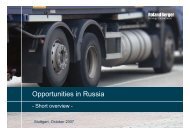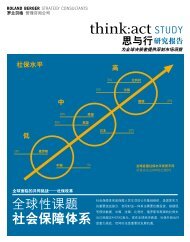Scenario planning â how to find the right strategy at ... - Roland Berger
Scenario planning â how to find the right strategy at ... - Roland Berger
Scenario planning â how to find the right strategy at ... - Roland Berger
Create successful ePaper yourself
Turn your PDF publications into a flip-book with our unique Google optimized e-Paper software.
Study 11<br />
2. Selecting<br />
stakeholders<br />
3. Conducting<br />
<strong>the</strong> survey<br />
<strong>Scenario</strong> <strong>planning</strong> can help companies better anticip<strong>at</strong>e <strong>how</strong><br />
macro-environment events could affect future performance and<br />
business opportunities. A key initial step is <strong>to</strong> canvass <strong>the</strong> views<br />
and opinions of <strong>the</strong> most important internal stakeholders, such<br />
as board members, <strong>to</strong>p executives, key str<strong>at</strong>egic and managerial<br />
staff, and industry experts. When assessing emerging country<br />
markets, we also identify appropri<strong>at</strong>e external stakeholders and<br />
market experts, such as politicians, members of <strong>the</strong> chamber of<br />
commerce or local cus<strong>to</strong>mers and suppliers. Identifying and<br />
accessing <strong>the</strong> most knowledgeable individuals may not proceed<br />
as efficiently as in familiar or advanced markets, but <strong>the</strong>ir voices<br />
are critically important. It's also advisable <strong>to</strong> interview people<br />
who work <strong>at</strong> competi<strong>to</strong>rs. One leading German electronics group,<br />
for example, always <strong>at</strong>tempts <strong>to</strong> talk with local competi<strong>to</strong>rs' staff<br />
before launching oper<strong>at</strong>ions in a newly industrializing country.<br />
Plant visits can also offer valuable insights in<strong>to</strong> local conditions.<br />
In our survey, we approach a broad range of stakeholders and<br />
generally 40 <strong>to</strong> 50 respondents particip<strong>at</strong>e.<br />
To illustr<strong>at</strong>e <strong>how</strong> we conduct <strong>the</strong> survey and apply its <strong>find</strong>ings <strong>to</strong><br />
cre<strong>at</strong>e key scenarios, we'll refer <strong>to</strong> <strong>the</strong> previously mentioned<br />
global manufacturing industry study. We start by using <strong>Roland</strong><br />
<strong>Berger</strong>'s "360° stakeholder feedback questionnaire" <strong>to</strong> identify<br />
those fac<strong>to</strong>rs most likely <strong>to</strong> affect <strong>the</strong> global manufacturing<br />
industry. First, we list influencing fac<strong>to</strong>rs along <strong>the</strong> so-called STEEP<br />
dimensions – Social, Technological, Economic, Environmental and<br />
Political/legal – and develop a questionnaire about <strong>the</strong>m. We <strong>the</strong>n<br />
distribute this questionnaire <strong>to</strong> internal stakeholders (across<br />
functions) and external experts (e.g. from local industry, think<br />
tanks, academia, etc.) across critical manufacturing sec<strong>to</strong>rs<br />
and geographical loc<strong>at</strong>ions. The respondents identify 40 <strong>to</strong> 50<br />
separ<strong>at</strong>e influencing fac<strong>to</strong>rs, which are <strong>the</strong>n clustered in a second<br />
survey <strong>to</strong> score each fac<strong>to</strong>r in terms of two key criteria:<br />
Impact – How significant<br />
is <strong>the</strong> influencing fac<strong>to</strong>r<br />
in a global context<br />
Certainty – Wh<strong>at</strong> is <strong>the</strong><br />
probability <strong>the</strong> influencing<br />
fac<strong>to</strong>r will occur





